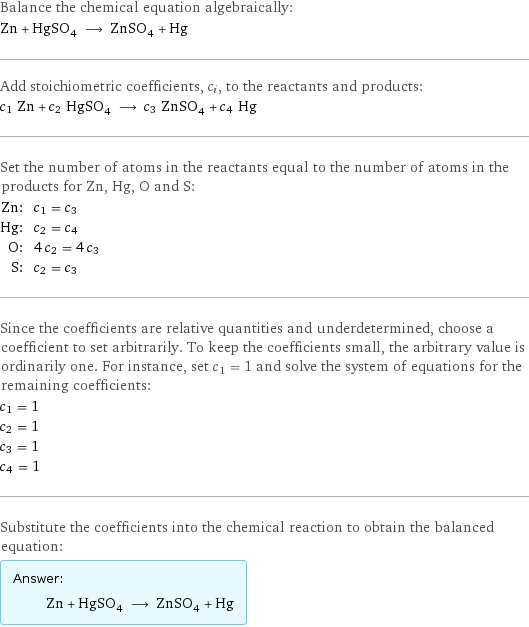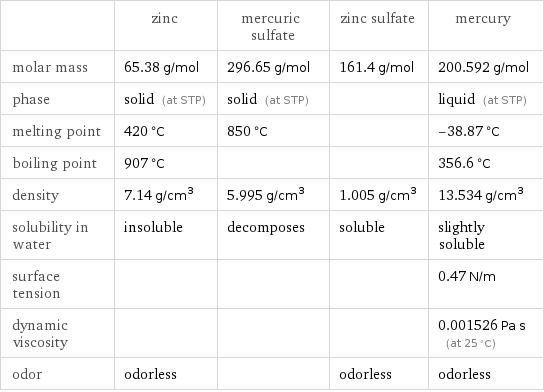Input interpretation

Zn zinc + HgSO_4 mercuric sulfate ⟶ ZnSO_4 zinc sulfate + Hg mercury
Balanced equation

Balance the chemical equation algebraically: Zn + HgSO_4 ⟶ ZnSO_4 + Hg Add stoichiometric coefficients, c_i, to the reactants and products: c_1 Zn + c_2 HgSO_4 ⟶ c_3 ZnSO_4 + c_4 Hg Set the number of atoms in the reactants equal to the number of atoms in the products for Zn, Hg, O and S: Zn: | c_1 = c_3 Hg: | c_2 = c_4 O: | 4 c_2 = 4 c_3 S: | c_2 = c_3 Since the coefficients are relative quantities and underdetermined, choose a coefficient to set arbitrarily. To keep the coefficients small, the arbitrary value is ordinarily one. For instance, set c_1 = 1 and solve the system of equations for the remaining coefficients: c_1 = 1 c_2 = 1 c_3 = 1 c_4 = 1 Substitute the coefficients into the chemical reaction to obtain the balanced equation: Answer: | | Zn + HgSO_4 ⟶ ZnSO_4 + Hg
Structures

+ ⟶ +
Names

zinc + mercuric sulfate ⟶ zinc sulfate + mercury
Equilibrium constant
![Construct the equilibrium constant, K, expression for: Zn + HgSO_4 ⟶ ZnSO_4 + Hg Plan: • Balance the chemical equation. • Determine the stoichiometric numbers. • Assemble the activity expression for each chemical species. • Use the activity expressions to build the equilibrium constant expression. Write the balanced chemical equation: Zn + HgSO_4 ⟶ ZnSO_4 + Hg Assign stoichiometric numbers, ν_i, using the stoichiometric coefficients, c_i, from the balanced chemical equation in the following manner: ν_i = -c_i for reactants and ν_i = c_i for products: chemical species | c_i | ν_i Zn | 1 | -1 HgSO_4 | 1 | -1 ZnSO_4 | 1 | 1 Hg | 1 | 1 Assemble the activity expressions accounting for the state of matter and ν_i: chemical species | c_i | ν_i | activity expression Zn | 1 | -1 | ([Zn])^(-1) HgSO_4 | 1 | -1 | ([HgSO4])^(-1) ZnSO_4 | 1 | 1 | [ZnSO4] Hg | 1 | 1 | [Hg] The equilibrium constant symbol in the concentration basis is: K_c Mulitply the activity expressions to arrive at the K_c expression: Answer: | | K_c = ([Zn])^(-1) ([HgSO4])^(-1) [ZnSO4] [Hg] = ([ZnSO4] [Hg])/([Zn] [HgSO4])](../image_source/7a937f471b5e6d783cf9a144f41035a4.png)
Construct the equilibrium constant, K, expression for: Zn + HgSO_4 ⟶ ZnSO_4 + Hg Plan: • Balance the chemical equation. • Determine the stoichiometric numbers. • Assemble the activity expression for each chemical species. • Use the activity expressions to build the equilibrium constant expression. Write the balanced chemical equation: Zn + HgSO_4 ⟶ ZnSO_4 + Hg Assign stoichiometric numbers, ν_i, using the stoichiometric coefficients, c_i, from the balanced chemical equation in the following manner: ν_i = -c_i for reactants and ν_i = c_i for products: chemical species | c_i | ν_i Zn | 1 | -1 HgSO_4 | 1 | -1 ZnSO_4 | 1 | 1 Hg | 1 | 1 Assemble the activity expressions accounting for the state of matter and ν_i: chemical species | c_i | ν_i | activity expression Zn | 1 | -1 | ([Zn])^(-1) HgSO_4 | 1 | -1 | ([HgSO4])^(-1) ZnSO_4 | 1 | 1 | [ZnSO4] Hg | 1 | 1 | [Hg] The equilibrium constant symbol in the concentration basis is: K_c Mulitply the activity expressions to arrive at the K_c expression: Answer: | | K_c = ([Zn])^(-1) ([HgSO4])^(-1) [ZnSO4] [Hg] = ([ZnSO4] [Hg])/([Zn] [HgSO4])
Rate of reaction
![Construct the rate of reaction expression for: Zn + HgSO_4 ⟶ ZnSO_4 + Hg Plan: • Balance the chemical equation. • Determine the stoichiometric numbers. • Assemble the rate term for each chemical species. • Write the rate of reaction expression. Write the balanced chemical equation: Zn + HgSO_4 ⟶ ZnSO_4 + Hg Assign stoichiometric numbers, ν_i, using the stoichiometric coefficients, c_i, from the balanced chemical equation in the following manner: ν_i = -c_i for reactants and ν_i = c_i for products: chemical species | c_i | ν_i Zn | 1 | -1 HgSO_4 | 1 | -1 ZnSO_4 | 1 | 1 Hg | 1 | 1 The rate term for each chemical species, B_i, is 1/ν_i(Δ[B_i])/(Δt) where [B_i] is the amount concentration and t is time: chemical species | c_i | ν_i | rate term Zn | 1 | -1 | -(Δ[Zn])/(Δt) HgSO_4 | 1 | -1 | -(Δ[HgSO4])/(Δt) ZnSO_4 | 1 | 1 | (Δ[ZnSO4])/(Δt) Hg | 1 | 1 | (Δ[Hg])/(Δt) (for infinitesimal rate of change, replace Δ with d) Set the rate terms equal to each other to arrive at the rate expression: Answer: | | rate = -(Δ[Zn])/(Δt) = -(Δ[HgSO4])/(Δt) = (Δ[ZnSO4])/(Δt) = (Δ[Hg])/(Δt) (assuming constant volume and no accumulation of intermediates or side products)](../image_source/1a2968aff90b5a14158cf5c55193bebf.png)
Construct the rate of reaction expression for: Zn + HgSO_4 ⟶ ZnSO_4 + Hg Plan: • Balance the chemical equation. • Determine the stoichiometric numbers. • Assemble the rate term for each chemical species. • Write the rate of reaction expression. Write the balanced chemical equation: Zn + HgSO_4 ⟶ ZnSO_4 + Hg Assign stoichiometric numbers, ν_i, using the stoichiometric coefficients, c_i, from the balanced chemical equation in the following manner: ν_i = -c_i for reactants and ν_i = c_i for products: chemical species | c_i | ν_i Zn | 1 | -1 HgSO_4 | 1 | -1 ZnSO_4 | 1 | 1 Hg | 1 | 1 The rate term for each chemical species, B_i, is 1/ν_i(Δ[B_i])/(Δt) where [B_i] is the amount concentration and t is time: chemical species | c_i | ν_i | rate term Zn | 1 | -1 | -(Δ[Zn])/(Δt) HgSO_4 | 1 | -1 | -(Δ[HgSO4])/(Δt) ZnSO_4 | 1 | 1 | (Δ[ZnSO4])/(Δt) Hg | 1 | 1 | (Δ[Hg])/(Δt) (for infinitesimal rate of change, replace Δ with d) Set the rate terms equal to each other to arrive at the rate expression: Answer: | | rate = -(Δ[Zn])/(Δt) = -(Δ[HgSO4])/(Δt) = (Δ[ZnSO4])/(Δt) = (Δ[Hg])/(Δt) (assuming constant volume and no accumulation of intermediates or side products)
Chemical names and formulas

| zinc | mercuric sulfate | zinc sulfate | mercury formula | Zn | HgSO_4 | ZnSO_4 | Hg Hill formula | Zn | HgO_4S | O_4SZn | Hg name | zinc | mercuric sulfate | zinc sulfate | mercury IUPAC name | zinc | mercury(+2) cation sulfate | zinc sulfate | mercury
Substance properties

| zinc | mercuric sulfate | zinc sulfate | mercury molar mass | 65.38 g/mol | 296.65 g/mol | 161.4 g/mol | 200.592 g/mol phase | solid (at STP) | solid (at STP) | | liquid (at STP) melting point | 420 °C | 850 °C | | -38.87 °C boiling point | 907 °C | | | 356.6 °C density | 7.14 g/cm^3 | 5.995 g/cm^3 | 1.005 g/cm^3 | 13.534 g/cm^3 solubility in water | insoluble | decomposes | soluble | slightly soluble surface tension | | | | 0.47 N/m dynamic viscosity | | | | 0.001526 Pa s (at 25 °C) odor | odorless | | odorless | odorless
Units
